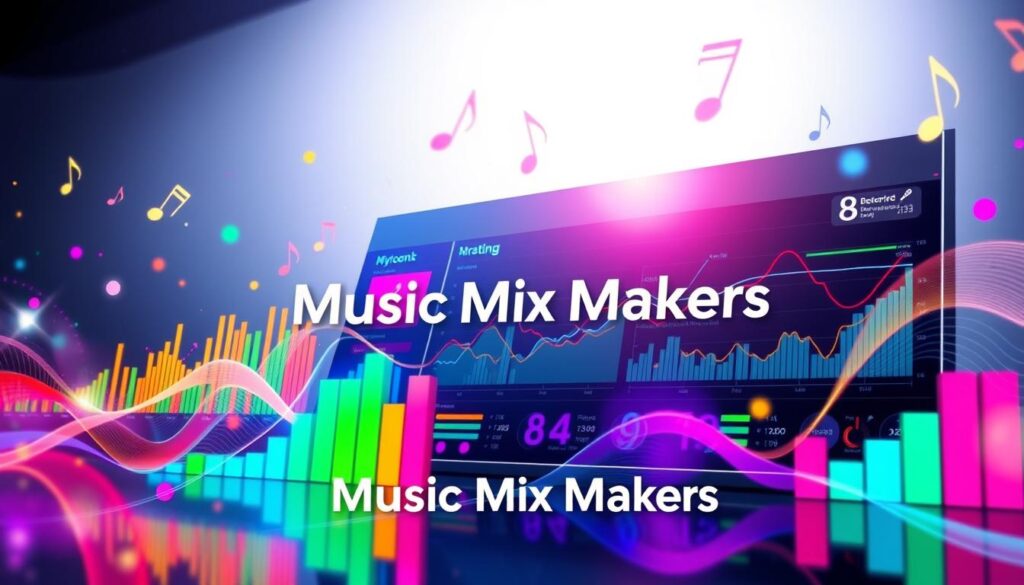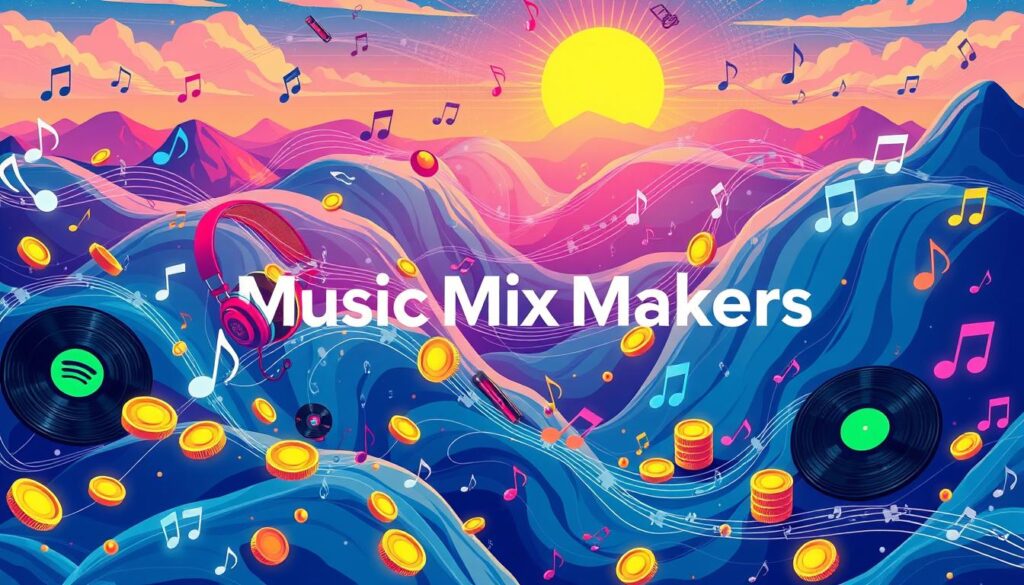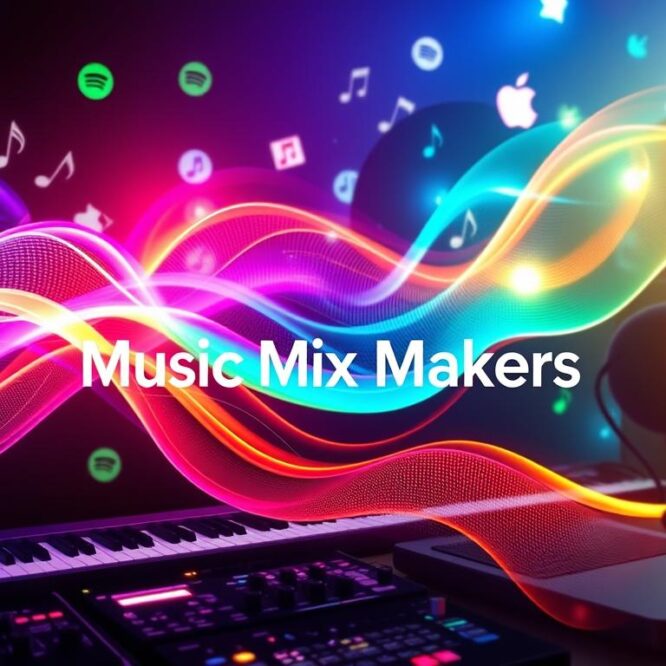As an aspiring musician, one of your primary goals is to get your music in front of as many listeners as possible. In today’s digital landscape, that means ensuring your tracks are available on the world’s leading music streaming platforms like Spotify and Apple Music. But navigating the process of uploading and distributing your music can be daunting, especially if you’re new to the industry. Fear not, my fellow artist – I’m here to guide you through the steps to get your music on Spotify, Apple Music, and beyond.
Key Takeaways
- Choose a reputable digital music distributor to partner with, such as TuneCore or DistroKid.
- Prepare your music files and metadata to ensure a smooth distribution process.
- Optimize your music release with compelling artwork, track details, and pre-order campaigns.
- Leverage social media and other promotional channels to build anticipation for your release.
- Monitor your streaming analytics to refine your marketing strategies and maximize royalties.
Overview: Releasing Music on Streaming Platforms
In the rapidly evolving music industry, the role of music distributors has become increasingly crucial. These intermediaries act as the gatekeepers, facilitating the seamless exchange of content, data, and payments between streaming services, download stores, and artists. By working with the right music distributors, artists can navigate the complex business landscape and focus on what they do best – creating and performing their art.
Understanding the Role of Music Distributors
Music distributors, such as TuneCore and DistroKid, play a vital role in the streaming music distribution ecosystem. They handle the intricate process of getting an artist’s music onto popular platforms like Spotify, Apple Music, and YouTube, ensuring their work is available to a vast audience. These distributors also manage the collection and distribution of royalties, streamlining the financial aspects of the industry.
Benefits of Working with Preferred Distributors
By partnering with preferred music distributors, artists can unlock a host of benefits that can significantly impact their success in the streaming era. These advantages include:
- Seamless Integration – Preferred distributors often have direct relationships with major streaming platforms, allowing for a smooth and efficient music release process.
- Expanded Services – Beyond distribution, preferred distributors may offer additional services such as publishing and performance rights management, as well as promotional tools and analytics.
- Prioritized Attention – Preferred distributors may provide enhanced support and visibility for the artist’s music, helping it stand out in the crowded digital landscape.
Leveraging the expertise and connections of preferred music distributors can be a game-changer for artists seeking to maximize the reach and impact of their streaming music releases.
| Distributor | Key Features | Pricing |
|---|---|---|
| TuneCore |
|
|
| DistroKid |
|
|
How to Get Your Music on Spotify and Apple Music
Independent artists looking to distribute their music on popular streaming platforms like Spotify and Apple Music have a few crucial steps to take. First and foremost, it’s essential to properly prepare your music files for streaming.
Preparing Your Music Files
The ideal file format for uploading to streaming services is typically 16-bit 44.1 kHz WAV or FLAC. These high-quality audio files will ensure your music sounds its best when listeners stream it. Additionally, make sure your metadata – the information that describes your songs, such as titles, artist names, and genres – is complete and accurate. This helps your music get properly categorized and discovered by potential fans.
Choosing a Digital Music Distributor
Once your music files are ready, you’ll need to select a reputable digital music distributor to handle the upload and distribution process. Popular options for independent artists include TuneCore and DistroKid. These platforms will guide you through the submission process, allowing you to target specific streaming services like Spotify and Apple Music. They’ll also ensure your metadata is properly configured and provide you with valuable insights into your music’s performance.
Preparing your music files properly and choosing the right digital distributor are crucial first steps to getting your songs heard on the world’s leading streaming platforms. By taking the time to optimize your tracks and distribution approach, you’ll be well on your way to connecting with a wider audience and growing your fanbase.
Creating and Optimizing Your Music Release
When preparing to release your music through streaming platforms like Spotify and Apple Music, it’s crucial to take the time to carefully enter all the necessary metadata and track details. This includes the song title, artist name, genre, language, and any explicit content information. Accurate and complete metadata will help ensure your music is easily discovered by listeners on these platforms.
Entering Song Details for Streaming
As you upload your music files, you’ll be prompted to provide a wealth of information about each track. Here are some key details you’ll want to double-check and optimize:
- Song Title – Make sure the title is spelled correctly and matches the actual song.
- Artist Name – Ensure the artist name is presented exactly as you want it to appear.
- Genre – Choose the most relevant genre categories to help listeners find your music.
- Language – Indicate the primary language of the lyrics.
- Explicit Content – Mark any tracks with mature content to allow age-appropriate filtering.
Taking the time to carefully enter this metadata will help optimize your music releases and make it easier for fans to discover your songs on streaming platforms.
Album Artwork Requirements for Streaming
In addition to the track details, you’ll also need to upload high-quality album artwork that meets the size and format requirements of the streaming services. This visual element is crucial for making your music stand out and creating a cohesive brand identity.
Ensuring your music metadata optimization and album artwork are properly configured will go a long way in helping your music get discovered and appreciated by listeners on Spotify, Apple Music, and beyond.
Submitting Your Music for Distribution
Congratulations! You’ve meticulously prepared your music files, entered all necessary metadata, and selected your preferred streaming platforms. Now, it’s time to submit your release for distribution. This crucial step in the digital music distribution process can determine the success of your music release timeline.
When submitting your music for distribution, your chosen digital distributor will work diligently to get your tracks onto the various streaming platforms you’ve chosen. Depending on the service, this process can take anywhere from a few days to a couple of weeks. It’s essential to double-check all the information you’ve provided to ensure a smooth and timely submission of your music for distribution.
To streamline the process, consider the following steps:
- Review all metadata and track details one last time to catch any potential errors.
- Ensure you’ve selected the appropriate streaming platforms for your music genre and target audience.
- Communicate with your digital distributor to understand their specific submission requirements and timelines.
- Be patient and allow your distributor the necessary time to complete the digital music distribution process.
Remember, a successful music release timeline often hinges on the quality of your pre-release preparation and the seamless execution of the submitting music for distribution phase. By following these best practices, you’ll be well on your way to getting your music in front of eager listeners on Spotify, Apple Music, and beyond.
“The key to a successful music release is a well-planned and executed distribution strategy.”
Promoting Your Music Release
Promoting your music release is a crucial step in building awareness and driving streams on platforms like Spotify and Apple Music. By leveraging social media and strategic pre-order campaigns, you can effectively generate excitement and anticipation around your new music.
Social Media Promotion Strategies
Utilize your social media platforms to share the news about your upcoming music release. Post engaging content that teases your new tracks, share behind-the-scenes glimpses, and encourage your followers to save or pre-order your music. Collaborating with influencers or other artists can also help expand your reach and connect with new potential listeners.
Building Anticipation with Pre-Orders
Pre-order campaigns can be a powerful way to build hype and anticipation leading up to your release date. Offer exclusive content, limited-edition merchandise, or special bundles to incentivize your fans to pre-order your music. This not only generates early sales but also creates a sense of excitement and commitment from your audience.
In addition to social media and pre-order campaigns, continue to promote your music through ongoing content creation, email newsletters, and other marketing channels. Keeping your fans engaged and informed will help maintain the momentum leading up to and following your music release.
“Promoting your music release is essential for driving streams and building a loyal fan base. Leverage social media and pre-order campaigns to create a buzz and drive anticipation for your new music.”
Tracking Your Music’s Performance
As an independent musician, monitoring the performance of your music on streaming platforms is crucial for making informed decisions about your marketing strategies. By analyzing streaming analytics, you can gain valuable insights into your audience and optimize your approach to reach more listeners.
Analyzing Streaming Analytics
The key to leveraging music streaming analytics is to focus on the metrics that matter most for your goals. Some of the important data points to track include:
- Stream volume: Understand how many people are listening to your music and which tracks are resonating the most.
- Listener demographics: Identify the age, gender, and geographic distribution of your audience to better target your data-driven music marketing efforts.
- Playlist placement: Track which playlists your music is featured on, as this can significantly impact your monitoring music performance.
By analyzing these music streaming analytics, you can make informed decisions about your promotional strategies, such as which platforms to focus on, what content to create, and how to engage your fans more effectively.
| Metric | Importance | Insights |
|---|---|---|
| Stream Volume | Understand the overall popularity of your music | Identify your most-streamed tracks and trends over time |
| Listener Demographics | Gain insights into your target audience | Tailor your marketing efforts to reach the right listeners |
| Playlist Placement | Assess the impact of playlist inclusion | Determine which playlists drive the most engagement |
By leveraging the power of music streaming analytics, you can make data-driven decisions to optimize your music marketing strategies and connect with your audience more effectively.

Music Metadata Optimization for Streaming Services
Optimizing your music’s metadata is crucial for improving its discoverability on platforms like Spotify and Apple Music. Metadata refers to the information that describes your songs, such as the title, artist name, genre, and other identifying details. By ensuring this data is accurate and well-optimized, you can enhance the visibility of your music and reach a wider audience on streaming services.
One of the key aspects of music metadata optimization is working closely with your digital distributor. They can help you enter all the necessary information correctly, from song titles and artist names to genre tags and release dates. Take the time to double-check every detail to ensure your metadata is as accurate as possible.
Additionally, take advantage of the artist dashboards provided by Spotify and Apple Music. These platforms allow you to further refine and optimize your music’s metadata, making it easier for users to find and stream your songs. Regularly review and update your metadata, as this can have a significant impact on music discoverability and optimizing songs for streaming.
Remember, music metadata optimization is an ongoing process, and staying on top of it can make a real difference in the performance of your music on streaming services. By ensuring your metadata is clean, accurate, and well-optimized, you can improve your chances of getting your music discovered by the right listeners and growing your fanbase.
Royalties and Payments for Streaming Music
As your music generates streams on platforms like Spotify and Apple Music, you’ll start to earn music streaming royalties. The amount you receive per stream can vary depending on several factors, including your distribution agreement, the streaming service’s payout rates, and your share of the royalties. It’s essential to understand how the artist payments for streaming process works and ensure you’re being paid accurately for your streams.
Your digital distributor will handle the collection and distribution of these royalties. They’ll negotiate deals with streaming platforms and collect the payments on your behalf. The royalty rates for understanding music royalties can be complex, with streaming services often paying a percentage of their revenue to rights holders.
- Streaming royalties are typically calculated based on a per-stream rate, which can range from $0.001 to $0.008 per stream, depending on the platform and your distribution agreement.
- Your share of the royalties will depend on your contractual arrangements with your record label, publisher, or distributor.
- Streaming services may also offer additional payments, such as advances, promotional bonuses, or revenue-sharing arrangements, which can further impact your overall earnings.
It’s crucial to regularly monitor your streaming analytics and royalty statements to ensure you’re being paid accurately. By understanding music streaming royalties, you can make informed decisions about your music distribution strategy and maximize your earnings from streaming platforms.

“The key to maximizing your streaming royalties is to stay informed, negotiate favorable deals, and closely monitor your performance across multiple platforms.”
Remember, the music industry is constantly evolving, and the landscape of artist payments for streaming can change over time. Stay up-to-date with industry trends and best practices to ensure you’re getting the most out of your music streaming royalties.
Spotify for Artists and Apple Music for Artists
As an artist navigating the ever-evolving music streaming landscape, it’s crucial to leverage the powerful tools and insights offered by Spotify for Artists and Apple Music for Artists. These dedicated platforms provide invaluable data and features to help you optimize your presence and better connect with your audience on these leading spotify for artists, apple music for artists, and other music streaming platform features for artists.
Spotify for Artists and Apple Music for Artists offer a wealth of insights into your streaming performance. You can access detailed analytics on your song and album metrics, including plays, listeners, and playlist placements. These platforms also provide demographic information about your fans, allowing you to better understand your audience and tailor your marketing efforts accordingly.
Beyond just analyzing your data, these platforms also empower you to take an active role in managing your presence. You can claim your artist profile, upload new music, and even pitch your tracks for inclusion on curated playlists. By leveraging these artist-focused features, you can ensure your music is reaching the right listeners and maximize your visibility on these leading streaming services.
| Feature | Spotify for Artists | Apple Music for Artists |
|---|---|---|
| Analytics | ✓ | ✓ |
| Fan Demographics | ✓ | ✓ |
| Claim Artist Profile | ✓ | ✓ |
| Music Uploads | ✓ | ✓ |
| Playlist Pitching | ✓ | ✓ |
By leveraging the features and insights provided by Spotify for Artists and Apple Music for Artists, you can optimize your presence, better understand your audience, and ultimately, enhance your success on these leading music streaming platforms.
Conclusion
In my journey to get my music on Spotify, Apple Music, and other leading streaming platforms, I’ve learned that partnering with a reputable digital distributor is key. By preparing my music files and metadata properly, I was able to enhance the discoverability and success of my releases on these services.
The tools provided by Spotify for Artists and Apple Music for Artists have been invaluable in tracking my music’s performance and optimizing my metadata for better visibility. Actively promoting my releases through social media and building anticipation with pre-orders have also played a crucial role in building my audience on these platforms.
As I reflect on this journey, the key takeaways for independent artists like myself are to understand the role of music distributors, utilize the resources offered by streaming services, and consistently work on optimizing and promoting your music. By embracing these strategies, I’m confident that I can continue to grow my presence on Spotify, Apple Music, and other streaming platforms, ultimately reaching more listeners and achieving greater success in my music career.
